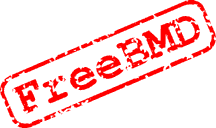
 Transcribing Scanned Source
Transcribing Scanned Source
 Transcribing Scanned Source
Transcribing Scanned SourceTranscribing from the scanned images is very similar to transcribing from the original film, and there are just a few administrative points that you need to be aware of. If you are new to transcribing you might want to read Information for New Transcribers first. Experienced and new transcribers may like to take advantage of some hints and tips which will enable you to make the most of the scanned images.
ACDB-ANC-DB-EW-Fiche-JM-LDS-LOMEL-MKL-NFHC-OFHS-ONS-UKC-UKD-1837M3-A-C-0134x.gif
(1837 Marriages, Quarter 3, Index A-C, Page 134)
1866M3-G-0134.tif
x and the lower half y.
There should always be an overlap between the two halves.
-rescan.
Once again, you should download all copies.
Transcribers are recommended to use one of two recently-updated transcription methods, WinBMD and BMDVerify (for Microsoft Windows only) or FreeComETT (for all operating systems including Window, Mac and Linux). Details of these are included in the List of Transcription Software.
| Q | A |
|---|---|
| What software do I need to download the scans? | Recent versions of WinBMD and FreeComETT will download your scans automatically once the relevant information
has been entered. If you wish, you may also use your ordinary internet browser, and possibly a graphics package capable of reading GIF,
JPEG or TIFF
files. See the Hints and Tips for information about
the sort of features your graphics package should have. |
| How big are the images? | Obviously the images vary in size, but most are about 1 MB in size. |
| What software do I need to transcribe the data? | Transcribers should use one of the two recommended transcription methods, WinBMD and BMDVerify (for Windows only) or FreeComETT (works with all operating systems as it uses the web browser already installed on your computer). See the List of Transcription Software. |
| How do I get my first allocation? | When you register with the syndicate, you will be allocated a page to transcribe and upload. |
| How do I get more allocations? | Your coordinator will tell you how to get more allocations when he sends you your first allocation. |
| How do I access the scans? | Click on the appropriate alphabetic range in the scan table or follow the instructions given by your co-ordinator. |
| What about entries that are hard to read? | If you have difficulty in reading some entries, you should read the information about representing uncertain characters on the Beginner's Help page. If you are transcribing from handwritten material, you may also find the page about reading Victorian handwriting useful. |
| What do I call my file? | The latest transcription software systems, WinBMD and FreeComETT, automatically create the correct file names. |
| What do I do with my file once I've transcribed it? | The latest transcription software systems, WinBMD and FreeComETT, are able to upload completed files to FreeBMD. In rare cases, you may need to upload the file. Contact your Syndicate Coordinator. Help on this process can be found in the Beginner's Help page. |
| Search engine, layout and database
Copyright © 1998-2025 Free UK Genealogy CIO, a charity registered in England and Wales, Number 1167484.
We make no warranty whatsoever as to the accuracy or completeness of the FreeBMD data. Use of the FreeBMD website is conditional upon acceptance of the Terms and Conditions |
 |